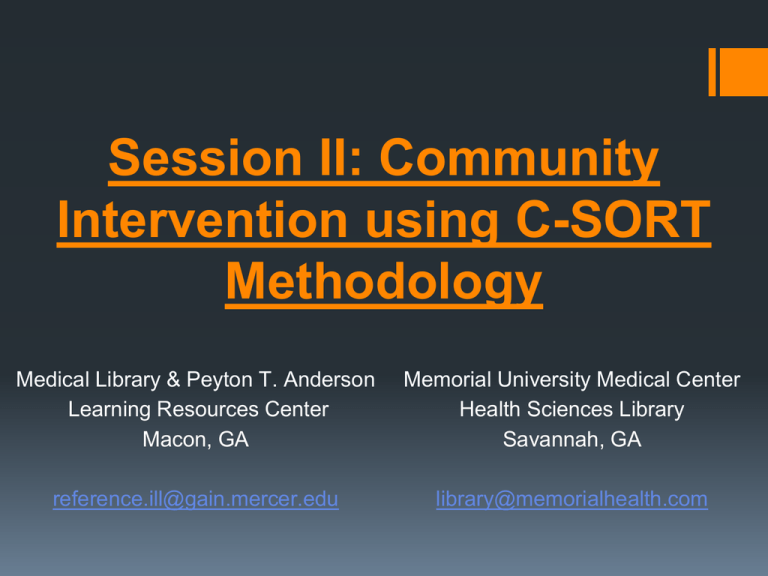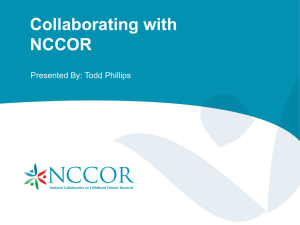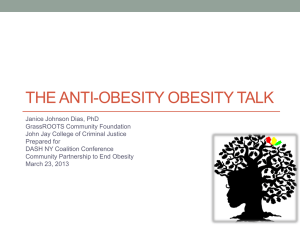
Session II: Community
Intervention using C-SORT
Methodology
Medical Library & Peyton T. Anderson
Learning Resources Center
Macon, GA
Memorial University Medical Center
Health Sciences Library
Savannah, GA
reference.ill@gain.mercer.edu
library@memorialhealth.com
Objectives
1. Participants will define a community intervention as
distinct from a patient clinical question.
2. Participants describe the elements of the C-SORT
methodology
3. Participants will work in groups to identify and locate
online resources to use when preparing a community
intervention, including:
1. CDC Statistical Resources
2. Healthy People 2020
3. County Health Rankings
4. Participants in groups will present their evaluation of the
community intervention resources to the class.
5. Participants will apply the final steps of C-SORT
Methodology through proactive class discussion.
Objective 1
Participants will define a community
intervention as distinct from a patient
clinical question. Participants describe
the elements of the C-SORT methodology
Your patient
Shannon, a 19-year-old African
American female, visits her
local health clinic for her annual
STD screening. Shannon is
asymptomatic but tests positive
for Syphilis. Tests also reveal
Shannon is 3-weeks pregnant.
Formulating a Clinical Question
Patient or Population
19-year-old African American female with Syphilis
and in 1st trimester of pregnancy, no known allergies
Intervention
Treatment with Penicillin
Comparison
Alternative treatments
Outcome
a healthy pregnancy and delivery for mom and baby;
prevention of congenital syphilis in baby
Multiple Cases
C-SORT Methodology
1. Community/ Characteristics
2. Standard
3. Options
4. Response
5. Transformation
Objective 2
Participants describe the
elements of the C-SORT
methodology
Letter – Meaning
Addresses
Example
C – Community
The community in which the physician is
Obesity is a problem throughout the population. Among
immersed. Namely, the group “title” of those with whom the children and adolescents, the prevalence of obesity is
physician is working.
highest among older and Mexican American children and
non-Hispanic black girls. The association of income with
obesity varies by age, gender, and race/ethnicity. Patients
living in the American South
C – Characteristics
Specific characteristics of the community or patient
group. This is the element that requires attention; the
“need.”
Access to and availability of healthier foods can help people
follow healthful diets. For example, better access to retail
venues that sell healthier options may have a positive
impact on a person’s diet; these venues may be less
available in low-income or rural neighborhoods.
The places where people eat appear to influence their diet.
S-Standard
Non clinical standard of care relative to the specific
characteristic. Clinical standards are addressed via clinical
questions. This standard relates more generally to
psychosocial, economic, educational standards answering
the question "What works?”.
Reduce the proportion of children and adolescents who are
considered obese
Increase the proportion of Americans who have access to a
food retail outlet that sells a variety of foods that are
encouraged by the Dietary Guidelines for Americans
O- Options
Defines options/opportunities available such as events,
Public Health Department, educational resources, local
resources, or other potential solutions in place to address or campaigns, CDC, Let’s Move
bolster the characteristics under investigation. Consider the
interaction and interdependence of various factors.
R – Response
Outlines the community physician’s desired response to the
characteristics under investigation. Describes what he/she
will do as a “responsive” physician to strengthen or
ameliorate desired outcomes or community direction.
Community presentations on the effects of childhood
obesity, billboards, school presentations. Developing
website with tools to help providers, parents, children, and
entire community with the issue.
T – Transformation
Discusses how the physician’s actions will transform the
community long term into a stronger population. Related to
standards as needed.
To reduce the prevalence of obesity in Muscogee County
and its surrounding community, and to encourage the
community as a whole to lead healthier lives.
Year 1 Year 2 Year 4
“C” Community/Characteristics
Letter –
Meaning
C–
Community
Addresses
The community in which the physician
is immersed. Namely, the group “title”
of those with whom the physician is
working.
C–
Specific characteristics of the
Characteristics community or patient group. This is the
element that requires attention; the
“need.”
Example
Obesity is a problem throughout the
population. Among children and
adolescents, the prevalence of obesity
is highest among older and Mexican
American children and non-Hispanic
black girls. The association of income
with obesity varies by age, gender, and
race/ethnicity. Patients living in the
American South
Access to and availability of healthier
foods can help people follow healthful
diets. For example, better access to
retail venues that sell healthier options
may have a positive impact on a
person’s diet; these venues may be
less available in low-income or rural
neighborhoods.
The places where people eat appear to
influence their diet.
Centers For Disease Control
1. Taking the health pulse of our nation
2. Detecting and responding to new and emerging
health threats
3. Tackling the biggest health problems causing
death and disability for Americans
4. Putting science and advanced technology into
action to prevent disease
5. Promoting healthy and safe behaviors,
communities and environment
6. Developing leaders and training the public
health workforce, including disease detectives
“C” Community/Characteristics
Need to update this slide with CDC image… looking for one.
County Health Rankings
Ranking the health of nearly
every county in the nation,
the County Health
Rankings illustrate what we
know when it comes to what’s
making people sick or healthy.
The County Health
Roadmaps show what we can
do to create healthier places to
live, learn, work and play.
S - Standard
Letter –
Meaning
S-Standard
Addresses
Non clinical standard of care
relative to the specific
characteristic. Clinical standards
are addressed via clinical
questions. This standard relates
more generally to psychosocial,
economic, educational standards
answering the question "What
works?”.
Example
Reduce the proportion of children
and adolescents who are
considered obese
Increase the proportion of
Americans who have access to a
food retail outlet that sells a
variety of foods that are
encouraged by the Dietary
Guidelines for Americans
O- Options
Letter –
Meaning
Addresses
Example
O- Options Defines options/opportunities Public Health Department,
available such as events,
educational resources, local
resources, or other potential campaigns, CDC, Let’s Move
solutions in place to address
or bolster the characteristics
under investigation. Consider
the interaction and
interdependence of various
factors.
Response: Childhood Obesity
Letter –
Meaning
R–
Response
Addresses
Example
Outlines the community
physician’s desired response to
the characteristics under
investigation. Describes what
he/she will do as a “responsive”
physician to strengthen or
ameliorate desired outcomes or
community direction.
Community presentations on
the effects of childhood obesity,
billboards, school
presentations. Developing
website with tools to help
providers, parents, children,
and entire community with the
issue.
Transformation: Childhood Obesity
Letter –
Meaning
T–
Transformation
Addresses
Example
Discusses how the physician’s
actions will transform the
community long term into a
stronger population. Related
to standards as needed.
To reduce the prevalence of
obesity in Muscogee County
and its surrounding
community, and to encourage
the community as a whole to
lead healthier lives.
Letter – Meaning
Addresses
Example
C – Community
The community in which the physician is
Obesity is a problem throughout the population. Among
immersed. Namely, the group “title” of those with whom the children and adolescents, the prevalence of obesity is
physician is working.
highest among older and Mexican American children and
non-Hispanic black girls. The association of income with
obesity varies by age, gender, and race/ethnicity. Patients
living in the American South
C – Characteristics
Specific characteristics of the community or patient
group. This is the element that requires attention; the
“need.”
Access to and availability of healthier foods can help people
follow healthful diets. For example, better access to retail
venues that sell healthier options may have a positive
impact on a person’s diet; these venues may be less
available in low-income or rural neighborhoods.
The places where people eat appear to influence their diet.
S-Standard
Non clinical standard of care relative to the specific
characteristic. Clinical standards are addressed via clinical
questions. This standard relates more generally to
psychosocial, economic, educational
standhttp://youtu.be/1t_H_DBHmGQards answering the
question "What works?”.
Reduce the proportion of children and adolescents who are
considered obese
Increase the proportion of Americans who have access to a
food retail outlet that sells a variety of foods that are
encouraged by the Dietary Guidelines for Americans
O- Options
Defines options/opportunities available such as events,
Public Health Department, educational resources, local
resources, or other potential solutions in place to address or campaigns, CDC, Let’s Move
bolster the characteristics under investigation. Consider the
interaction and interdependence of various factors.
R – Response
Outlines the community physician’s desired response to the
characteristics under investigation. Describes what he/she
will do as a “responsive” physician to strengthen or
ameliorate desired outcomes or community direction.
Community presentations on the effects of childhood
obesity, billboards, school presentations. Developing
website with tools to help providers, parents, children, and
entire community with the issue.
T – Transformation
Discusses how the physician’s actions will transform the
community long term into a stronger population. Related to
standards as needed.
To reduce the prevalence of obesity in Muscogee County
and its surrounding community, and to encourage the
community as a whole to lead healthier lives.
Year 1 Year 2 Year 4
Additional STD patients
Objective 3
Participants will work in groups to identify and
locate online resources to use when preparing a
community intervention, including:
1. CDC Statistical Resources
2. Healthy People 2020
3. County Health Rankings
Group Work
Letter – Meaning
C – Community
Addresses
Example
The community in which the physician Group 1 & 2
is immersed. Namely, the group “title”
of those with whom the physician is
working.
C – Characteristics Specific characteristics of the
Group 1 & 2
community or patient group. This is
the element that requires attention; the
“need.”
S-Standard
Non clinical standard of care relative
Group 3
to the specific characteristic. Clinical
standards are addressed via clinical
questions. This standard relates more
generally to psychosocial, economic,
educational standards answering the
question "What works?”
Group Work
Group 1:
Community/Characteristics
Evaluation at the National/State
Level using CDC website
Find the Syphilis Women Rates
Group 2:
Community/Characteristics
Evaluation at the County Level
using County Health Rankings
Find the STD rates for Bibb or
Chatham County
Group 3: Standards Evaluation
using the Healthy People 2020
Locate the standards that would
apply to the STD case
10 minutes prep, 5 minutes per
group for presentations
Some things to look for as you
review:
What kind of information did you
find?
Was it easy to locate the data?
Was the data recently updated?
What was the data source?
Any other findings from the site?
How would this information help
you to fulfill the C-SORT
Methodology?
Did the site link to other
resources?
What did you like or not like about
the site?
Objective 4
Participants in groups will present their
evaluation of the community intervention
resources to the class.
Group Work
Letter – Meaning
Addresses
C – Community The community in which the physician is
immersed. Namely, the group “title” of
those with whom the physician is
working.
Example
Pregnant racial minorities (predominantly
black and Hispanic), women of
childbearing years, patients living in the
American South
(http://www.cdc.gov/std/stats11/figures/e
.htm)
C–
Specific characteristics of the community STD infections, educational deficiencies,
Characteristics or patient group. This is the element that untreated syphilis
requires attention; the “need.”
S-Standard
Non clinical standard of care relative to
the specific characteristic. Clinical
standards are addressed via clinical
questions. This standard relates more
generally to psychosocial, economic,
educational standards answering the
question "What works?”.
By Year 2020 reduce the number of
congenital syphilis to 9.6 new cases per
100,000 live births. STD screenings for
pregnant women, STD treatment
services for women during childbearing
years, antenatal syphilis
screenings during first trimester,
antibiotic treatment if tested positive, late
(2-3rd trimester) prenatal care.
Objective 5
Participants will apply the final steps of C-SORT
Methodology through proactive class
discussion.
O- Options
Letter –
Meaning
Addresses
O- Options Defines options/opportunities
available such as events,
resources, or other potential
solutions in place to address
or bolster the characteristics
under investigation. Consider
the interaction and
interdependence of various
factors.
Example
Public health department,
educational resources, STD
prevention services,
incorporation into sex
education classes
Options for STD cases?
Response: STD Case
Letter –
Meaning
Addresses
R–
Outlines the community
Response physician’s desired
response to the
characteristics under
investigation. Describes
what he/she will do as a
“responsive” physician to
strengthen or ameliorate
desired outcomes or
community direction.
Example
Community presentations
on safe sex practices,
research studies with other
physicians, participation in
local programs in order to
set example of screening
practices.
Transformation: STD
Letter –
Meaning
Addresses
T–
Discusses how the
Transfor- physician’s actions will
mation
transform the community
long term into a stronger
population. Related to
standards as needed.
Example
To reduce and/or prevent
future cases of congenital
syphilis, to encourage
women to seek screening
and treatment early on
during their pregnancies.
Objectives
1. Participants will define a community intervention as
distinct from a patient clinical question.
2. Participants describe the elements of the C-SORT
methodology
3. Participants will work in groups to identify and locate
online resources to use when preparing a community
intervention, including:
1. CDC Statistical Resources
2. Healthy People 2020
3. County Health Rankings
4. Participants in groups will present their evaluation of the
community intervention resources to the class.
5. Participants will apply the final steps of C-SORT
Methodology through proactive class discussion.
Questions?






